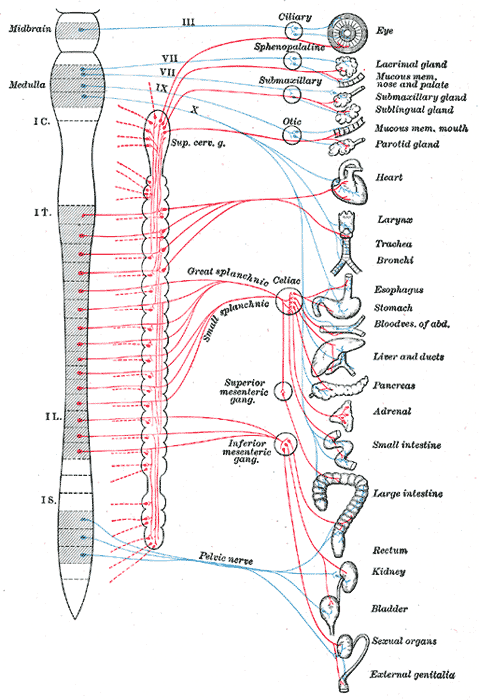Autonomic nervous system: Difference between revisions
imported>Robert Badgett |
imported>David E. Volk m (subpages) |
||
| Line 1: | Line 1: | ||
{{subpages}} | |||
[[Image:Gray839.gif|thumb|479px|The autonomic nervous system<br/>Blue = parasympathetic<BR>Red = sympathetic]] | [[Image:Gray839.gif|thumb|479px|The autonomic nervous system<br/>Blue = parasympathetic<BR>Red = sympathetic]] | ||
| Line 20: | Line 21: | ||
==References== | ==References== | ||
<references/> | <references/> | ||
Revision as of 08:40, 23 January 2008
The autonomic nervous system (ANS) (or visceral nervous system) is the part of the peripheral nervous system that acts as a control system, maintaining homeostasis in the body. These maintenance activities are primarily performed without conscious control or sensation. The ANS has far reaching effects, including: heart rate, digestion, respiration rate, salivation, perspiration, diameter of the pupils, micturition (the discharge of urine), and sexual arousal. Whereas most of its actions are involuntary, some ANS functions work in tandem with the conscious mind, such as breathing. Its main components are its sensory system, motor system (comprised of the parasympathetic nervous system and sympathetic nervous system), and the enteric nervous system.
Components
Sympathetic nervous system
Promotes a "fight or flight" response, corresponds with arousal and energy generation, inhibits digestion.
Parasympathetic nervous system
Promotes a "rest and digest" response; promotes calming of the nerves return to regular function, and enhances digestion.
